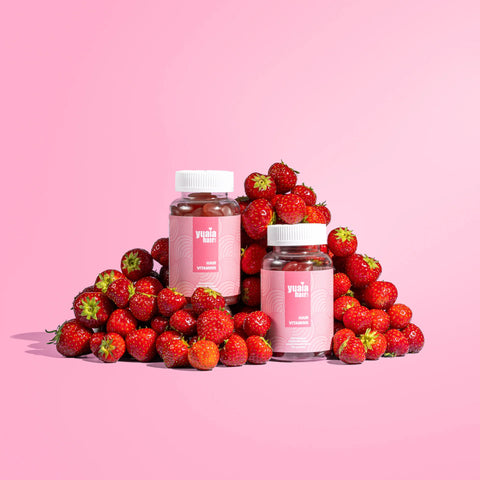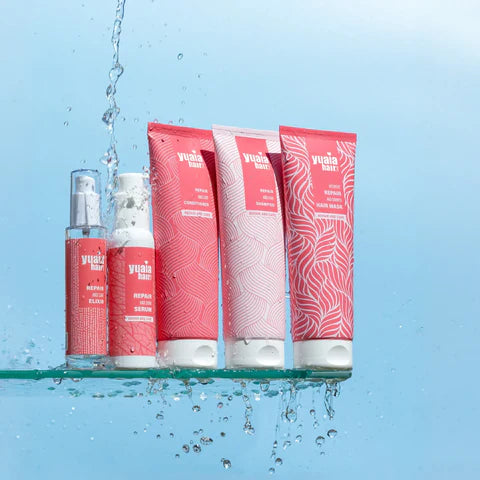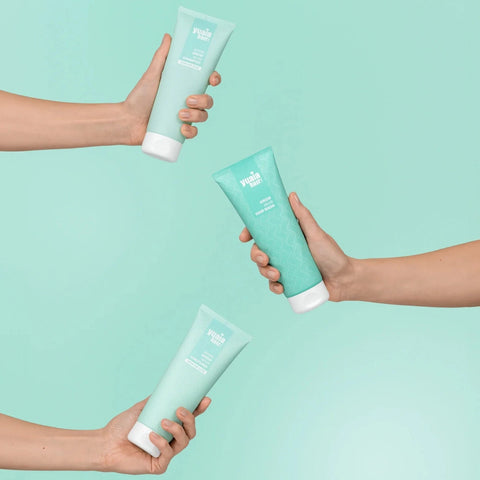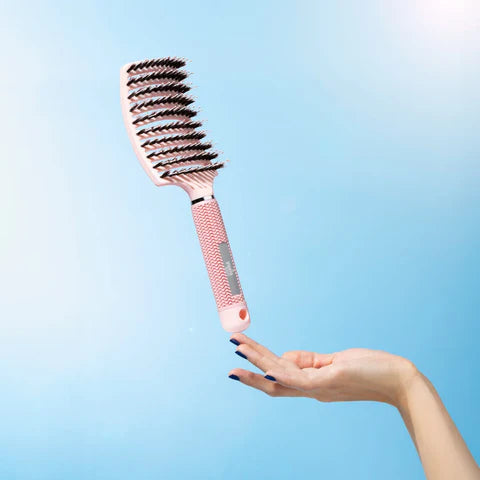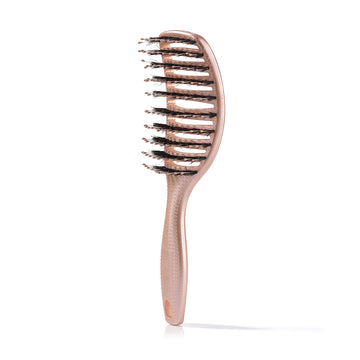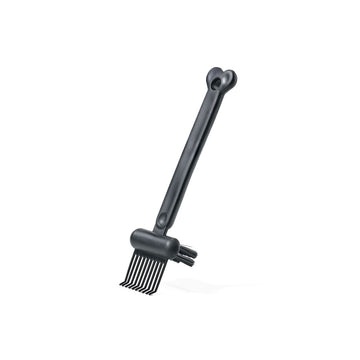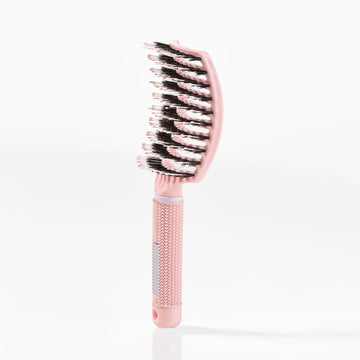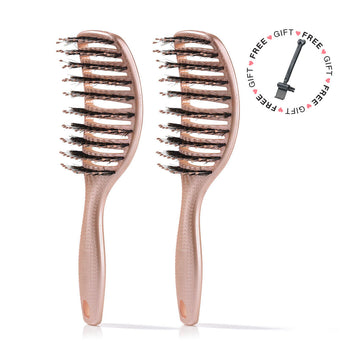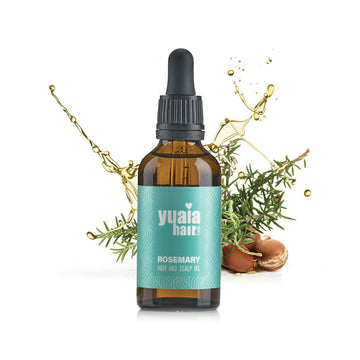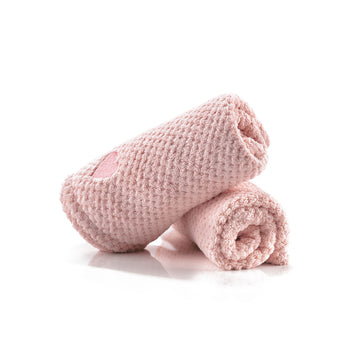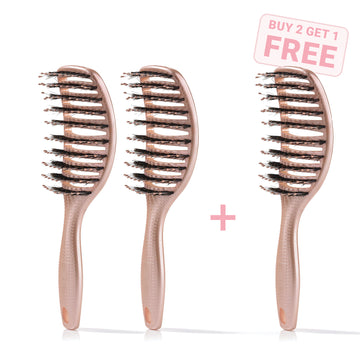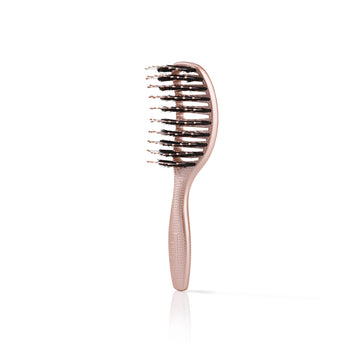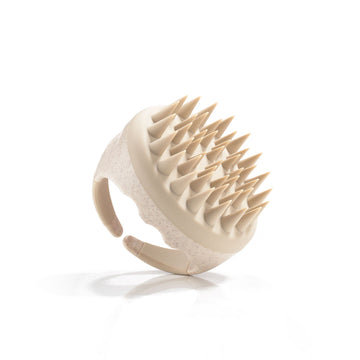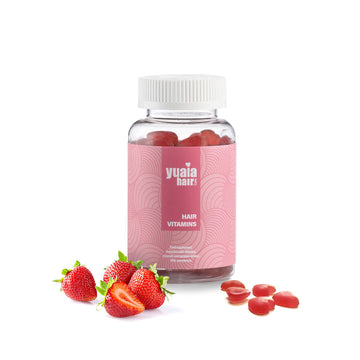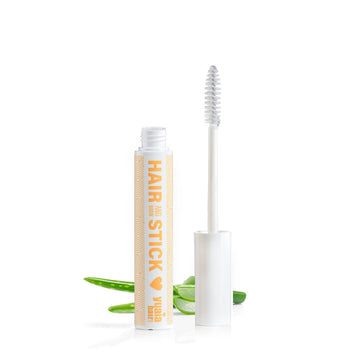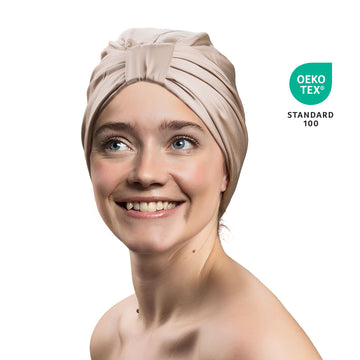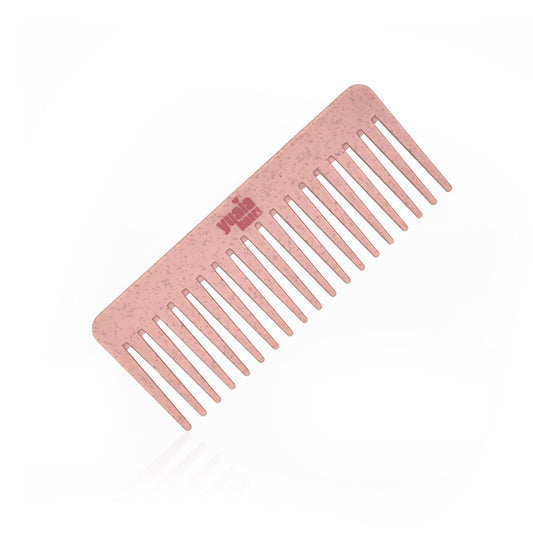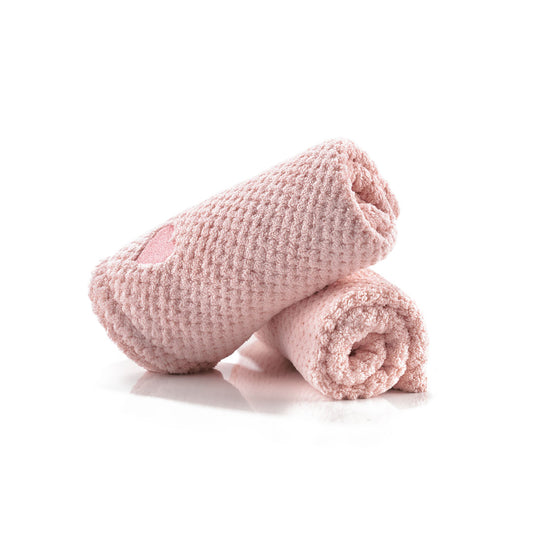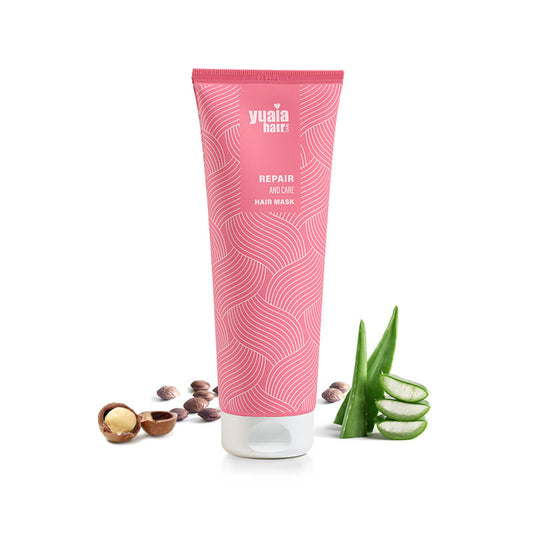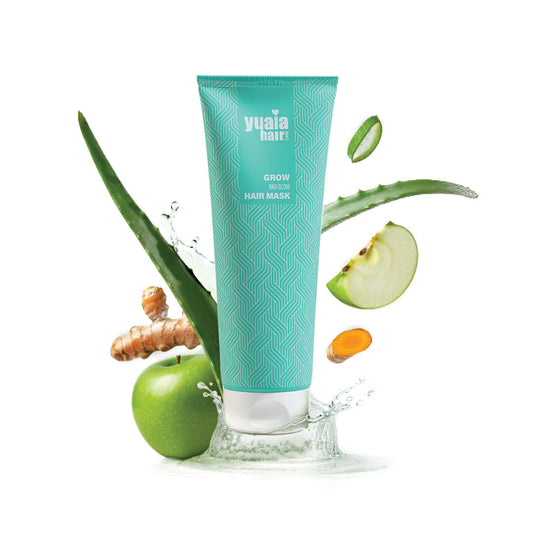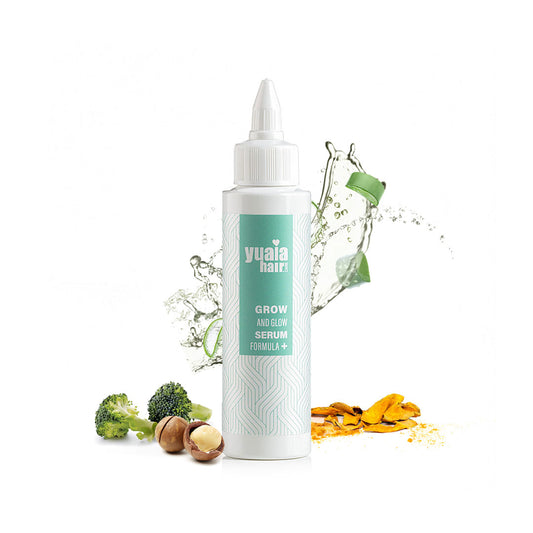
¿Cuál es la diferencia entre el acondicionamiento regular y el acondicionamiento profundo?
Tanto los acondicionadores regulares como los tratamientos de acondicionamiento profundo desempeñan un papel esencial en el cuidado del cabello, pero difieren significativamente en función y aplicación.
- Acondicionadores normales: diseñados para un uso rutinario que mantenga la suavidad y manejabilidad del cabello, los acondicionadores normales actúan principalmente en la superficie del cabello, proporcionando una rápida capa de hidratación y protección. Por lo general, se aplican después del champú y se dejan en el cabello durante 1-3 minutos antes de aclarar. Sus efectos son relativamente a corto plazo, por lo que requieren un uso constante para mantener los resultados.
- Tratamientos acondicionadores profundos: Por el contrario, los acondicionadores profundos están formulados para penetrar en el tallo del cabello, aportando nutrientes al núcleo de cada hebra. Abordan la sequedad y el daño más severos proporcionando una hidratación y reparación intensivas. Los acondicionadores profundos suelen ser de consistencia más espesa y requieren un tiempo de tratamiento más largo, a menudo entre 10 y 30 minutos, para permitir que los ingredientes penetren completamente en el cabello. Los resultados son más duraderos en comparación con los acondicionadores normales.
¿Cuáles son los beneficios de los tratamientos capilares de acondicionamiento profundo?
Los tratamientos capilares de acondicionamiento profundo proporcionan numerosas ventajas, entre las que se incluyen:
Restauración de la humedad
Los tratamientos de acondicionamiento profundo son una forma eficaz de restaurar los niveles de humedad del cabello. Al proporcionar una hidratación intensa, ayudan a reponer el equilibrio de humedad natural del cabello, dejándolo suave, flexible y con un aspecto saludable. Esto es especialmente importante para el cabello expuesto a factores ambientales estresantes como la exposición al sol, la contaminación o el peinado frecuente con calor, que pueden agotar la humedad y causar sequedad. Incorporar un tratamiento de acondicionamiento profundo asegura que tu cabello permanezca hidratado y mejor equipado para soportar el desgaste diario.
Reparación de daños
Los daños causados por tratamientos químicos, calor excesivo o peinados agresivos pueden debilitar el cabello con el tiempo. Los acondicionadores profundos contienen ingredientes específicamente diseñados para penetrar en el tallo del cabello y reparar los daños internos. Al fortalecer el cabello desde el interior, estos tratamientos reducen la probabilidad de rotura y puntas abiertas. El uso regular no solo mejora el estado inmediato del cabello, sino que también mejora su resistencia y salud general a largo plazo.
Mejora de la elasticidad y la fuerza del cabello
La elasticidad es clave para mantener un cabello sano y flexible. Los tratamientos de acondicionamiento profundo ayudan a mejorar la elasticidad del cabello, permitiendo que los mechones se estiren más sin romperse. Esta flexibilidad reduce la rotura y ayuda a prevenir las puntas abiertas, promoviendo un cabello más fuerte y saludable que puede soportar el peinado y la manipulación de manera más efectiva.
Mejora de la manejabilidad y reducción del encrespamiento
Uno de los beneficios más notables del acondicionamiento profundo es la mejora en la manejabilidad del cabello. Estos tratamientos suavizan la cutícula del cabello, lo que facilita desenredarlo y peinarlo. Además, combaten el encrespamiento al retener la humedad y crear una barrera protectora contra la humedad. El resultado es un cabello liso y pulido que es más fácil de mantener.
Promoción de la salud del cuero cabelludo
Un cuero cabelludo sano es la base para un cabello fuerte y vibrante, y los tratamientos de acondicionamiento profundo pueden desempeñar un papel importante en el mantenimiento de la salud del cuero cabelludo. Muchas fórmulas incluyen ingredientes como aloe vera, aceite de jojoba y aceite de argán, que proporcionan hidratación y nutrición al cuero cabelludo. Esto ayuda a reducir problemas comunes como la sequedad, la descamación y la irritación. Al calmar el cuero cabelludo y restaurar su equilibrio de humedad, los acondicionadores profundos crean un entorno que favorece el crecimiento saludable del cabello. Incorporar estos tratamientos a tu rutina no solo mejora la condición de tu cuero cabelludo, sino que también contribuye a un cabello más fuerte y brillante con el tiempo.
Cómo realizar un tratamiento capilar de acondicionamiento profundo
Realizar un tratamiento de acondicionamiento profundo en casa es una forma fácil pero eficaz de mejorar la salud y el aspecto de tu cabello. Aquí tienes una guía paso a paso para ayudarte a conseguir resultados de calidad profesional:
1. Elige el producto adecuado: Selecciona un acondicionador profundo adaptado a tu tipo de cabello y a tus necesidades específicas. Por ejemplo, opta por fórmulas ricas en humedad si tienes el cabello seco, o por tratamientos a base de proteínas para las hebras dañadas.
2. Lávate el cabello: Empieza con un champú a fondo para eliminar la suciedad, la grasa y la acumulación de productos. Esto garantiza que el acondicionador profundo pueda penetrar eficazmente en el tallo del cabello.
3. Aplica el acondicionador profundo: Después de secarte el cabello ligeramente con una toalla, aplica el producto de manera uniforme desde la mitad hasta las puntas. Evita usar demasiado en el cuero cabelludo a menos que el producto esté hecho para el cuidado del cuero cabelludo. Sin embargo, si lo que buscas es la salud del cuero cabelludo, masajea suavemente una pequeña cantidad en las raíces.
4. Peinar: Utiliza un peine de púas anchas para desenredar el cabello y distribuir el acondicionador de manera uniforme. Este paso garantiza que todas las hebras queden cubiertas.
5. Dejar actuar: Sigue el tiempo recomendado en la etiqueta del producto, normalmente de 10 a 30 minutos. Para maximizar la absorción, envuelve el cabello con un gorro de ducha y aplica calor con una toalla caliente, un vaporizador de cabello o un secador con capucha.
6. Enjuague bien: Use agua fría para enjuagar el acondicionador por completo. Este paso sella la cutícula, retiene la humedad y deja el cabello suave y brillante.
7. Seque y peine: Seque suavemente el cabello con una toalla de microfibra y péinelo como desee. Evite el calor excesivo para preservar los beneficios del tratamiento.
Recomendaciones de frecuencia basadas en el tipo y la condición del cabello
Determinar la frecuencia con la que acondicionar en profundidad el cabello depende de su tipo, estado y necesidades específicas. Adaptar la frecuencia garantiza que se aproveche al máximo los tratamientos sin sobrecargar el cabello.
Cabello seco o dañado: para el cabello que se siente quebradizo, apagado o con falta de humedad, aplique el acondicionador en profundidad una vez a la semana. Los tratamientos regulares ayudarán a restaurar la hidratación, reparar el daño y prevenir más roturas.
Cabello graso o fino: el cabello que tiende a engrasarse rápidamente o que carece de volumen debe acondicionarse en profundidad con moderación. Limite los tratamientos a una vez cada dos semanas, aplicando el acondicionador principalmente en los medios y las puntas para evitar que las raíces se apelmacen.
Cabello rizado o texturizado: los rizos prosperan con la humedad, por lo que es esencial un acondicionamiento profundo semanal. Esta rutina ayuda a mantener la elasticidad, reducir el encrespamiento y mejorar la definición de los rizos, lo que facilita el peinado.
Cabello teñido o tratado químicamente: El cabello que ha sido decolorado, teñido o alisado químicamente es más propenso a la sequedad y al daño. Aplique un acondicionador profundo semanalmente para preservar la intensidad del color, fortalecer el cabello y evitar que se desvanezca o se vuelva quebradizo.
Es importante controlar cómo responde el cabello y ajustar la frecuencia según sea necesario. Si no está segura, consulte a un profesional del cuidado del cabello para obtener orientación personalizada. Con el enfoque adecuado, el acondicionamiento profundo puede convertirse en un paso transformador para mantener un cabello sano y vibrante.
Mascarillas capilares de acondicionamiento profundo recomendadas
Elegir la mascarilla de acondicionamiento profundo adecuada puede marcar la diferencia en su rutina de cuidado del cabello. A continuación se presentan dos opciones altamente efectivas de Yuaia Haircare, cada una adaptada para abordar preocupaciones específicas del cabello.
Mascarilla capilar Repair and Growth
La mascarilla capilar Repair and Growth está hecha para reparar y fortalecer el cabello dañado, a la vez que mejora su resistencia general. Esta mascarilla está enriquecida con queratina, que ayuda a reconstruir el tallo capilar, reduciendo la rotura y restaurando la elasticidad. Además, sus ingredientes hidratantes aseguran que tu cabello se mantenga suave, liso y sin encrespamiento.
Esta mascarilla es especialmente beneficiosa para aquellos con cabello debilitado por el calor del secador, la coloración o los factores ambientales estresantes. Su uso regular no solo mejora la textura del cabello, sino que también previene daños adicionales, dejándolo más sano y manejable con el tiempo.
Obtenga más información sobre la mascarilla capilar Repair and Growth aquí.
Mascarilla capilar Grow and Glow
La mascarilla capilar Grow and Glow se centra en promover el crecimiento del cabello y reducir la caída del cabello. Formulada con Capilia Longa, un ingrediente activo natural conocido por estimular los folículos pilosos, esta mascarilla ayuda a aumentar la densidad del cabello y a fortalecer las hebras desde la raíz hasta las puntas.
Además de promover el crecimiento, esta mascarilla también nutre e hidrata el cuero cabelludo, creando el ambiente perfecto para un cabello más saludable. Es ideal para cualquier persona que experimente un adelgazamiento del cabello o que busque mejorar el volumen y el brillo naturales de su cabello.
Obtenga más información sobre la mascarilla capilar Grow and Glow aquí.
Las mejores recetas caseras para mascarillas capilares de acondicionamiento profundo
Crear sus propias mascarillas capilares de acondicionamiento profundo es una forma sencilla de satisfacer las necesidades únicas de su cabello utilizando ingredientes naturales. Las mascarillas caseras son rentables y no contienen productos químicos agresivos, por lo que ofrecen una alternativa personalizada y nutritiva a los productos comprados en tiendas. Con los ingredientes adecuados, estos tratamientos pueden restaurar la hidratación, reparar los daños y mejorar la salud general de tu cabello.
Ya sea que tu objetivo sea la hidratación, el control del encrespamiento o el fortalecimiento, las mascarillas caseras que utilizan ingredientes como el aceite de coco, el aloe vera o el aceite de jojoba pueden proporcionar resultados impresionantes. Aquí tienes algunas recetas eficaces que te ayudarán a dejar tu cabello suave, liso y manejable.
Mascarilla de aceite de coco y aceite de jojoba
El aceite de coco es un ingrediente muy eficaz para el acondicionamiento profundo, gracias a su capacidad para penetrar en el tallo del cabello y proporcionar una hidratación intensa. Esto no solo restaura la humedad, sino que también fortalece el cabello, reduciendo la rotura y las puntas abiertas. El aceite de jojoba complementa al aceite de coco con sus propiedades suavizantes, lo que lo hace ideal para domar el encrespamiento y mejorar el brillo. Juntos, estos aceites crean una mascarilla potente y natural que nutre y revitaliza el cabello.
Ingredientes:
- 2 cucharadas de aceite de coco
- 1 cucharada de aceite de jojoba
Instrucciones:
- Mezclar el aceite de coco y el aceite de jojoba hasta que estén completamente mezclados.
- Aplicar la mezcla uniformemente sobre el cabello húmedo, concentrándose en los medios y las puntas, donde la sequedad es más común.
- Deja la mascarilla puesta durante 30 minutos para que los aceites nutran el cabello en profundidad.
- Aclara bien con un champú sin sulfatos para eliminar cualquier residuo.
Esta mascarilla sencilla pero eficaz es adecuada para todo tipo de cabello, especialmente para el cabello seco o encrespado, dejándolo más suave, liso y manejable.
Mascarilla de aceite de argán y aceite de coco
El aceite de argán, a menudo llamado «oro líquido», está repleto de vitaminas y ácidos grasos que hidratan y suavizan profundamente el cabello. Hace maravillas reparando el daño y mejorando el brillo. Cuando se combina con aceite de coco, que penetra en el tallo del cabello para hidratarlo, esta mascarilla se convierte en un poderoso tratamiento para el cabello seco, encrespado o dañado. El uso regular de esta mascarilla puede dejar tu cabello más suave, fuerte y manejable.
Ingredientes:
- 2 cucharadas de aceite de coco
- 1 cucharada de aceite de argán
Instrucciones:
- Mezcla el aceite de coco y el aceite de argán hasta que la mezcla esté suave y bien combinada.
- Aplica la mascarilla uniformemente sobre el cabello limpio y húmedo, centrándote en los medios y las puntas para tratar la sequedad y el daño.
- Cubre tu cabello con un gorro de ducha y deja la mascarilla puesta durante 20-30 minutos para permitir que los aceites se absorban por completo.
- Aclare bien con agua tibia y continúe con su rutina habitual de cuidado del cabello.
Esta mascarilla es especialmente beneficiosa para el cabello expuesto a tratamientos térmicos o químicos, ya que lo deja más sano y brillante.
Mascarilla de aceite de jojoba y aloe vera
El aloe vera es ampliamente reconocido por sus propiedades calmantes e hidratantes, lo que lo convierte en una excelente opción para reducir la irritación y la sequedad del cuero cabelludo. No solo calma el picor del cuero cabelludo, sino que también proporciona la humedad esencial al cabello. El aceite de jojoba actúa en armonía con el aloe vera fortaleciendo las hebras de cabello y añadiendo un brillo natural y saludable. Esta combinación crea un tratamiento nutritivo que promueve la salud general del cuero cabelludo al tiempo que mejora la textura y la manejabilidad del cabello.
Ingredientes:
- 2 cucharadas de gel de aloe vera
- 1 cucharada de aceite de jojoba
Instrucciones:
- Mezcle el gel de aloe vera y el aceite de jojoba en un bol hasta que estén bien mezclados.
- Aplique la mezcla uniformemente en el cuero cabelludo y el cabello, masajeando suavemente las raíces para favorecer la circulación y la absorción.
- Deje la mascarilla puesta durante 15-20 minutos para que los ingredientes hidraten y fortalezcan.
- Aclare bien con agua tibia, asegurándose de que no queden residuos.
Esta mascarilla es ideal para quienes buscan un tratamiento ligero que calme el cuero cabelludo y deje el cabello suave, brillante y fresco. Es perfecta para un uso regular y mantener un cabello sano y brillante.
¿Cómo elijo la mascarilla capilar acondicionadora profunda adecuada?
Elegir la mascarilla capilar acondicionadora profunda adecuada es crucial para abordar eficazmente las necesidades específicas de su cabello. Empiece por evaluar los siguientes factores:
Tipo de cabello: Cada tipo de cabello requiere un cuidado específico. El cabello rizado suele beneficiarse de fórmulas ricas en humedad para mantener la elasticidad y reducir el encrespamiento, mientras que el cabello fino o delgado a menudo requiere mascarillas ligeras que no lo apelmacen.
Porosidad del cabello: La porosidad del cabello influye en la capacidad de absorción y retención de humedad. El cabello de alta porosidad, a menudo resultado de daños, se beneficia de mascarillas ricas en proteínas que fortalecen y fortifican el tallo capilar. Por el contrario, el cabello de baja porosidad, que puede ser resistente a la absorción de humedad, responde bien a las mascarillas ligeras y profundamente hidratantes que penetran en la cutícula.
Preocupaciones específicas: Concéntrese en abordar sus principales problemas capilares. Si está combatiendo el daño o las puntas abiertas, opte por una mascarilla fortalecedora. Para el encrespamiento y la sequedad, lo ideal es una mascarilla hidratante con ingredientes suavizantes. Si le preocupa la caída o el debilitamiento del cabello, elija una mascarilla con propiedades nutritivas que promuevan la salud del cuero cabelludo y estimulen el crecimiento.
Al comprender las necesidades de tu cabello, puedes seleccionar una mascarilla que mejore su salud y apariencia, lo que dará como resultado un cabello más suave, brillante y resistente.
Recomendaciones de productos o ingredientes adecuados para diferentes necesidades
El acondicionamiento profundo se centra en proporcionar una hidratación, reparación y nutrición intensas para tratar preocupaciones específicas del cabello. Los productos e ingredientes adecuados garantizan que tu tratamiento satisfaga las necesidades únicas de tu cabello.
Para el cabello dañado: Las mascarillas de acondicionamiento profundo con proteínas como la queratina y la proteína de trigo hidrolizada ayudan a reparar y fortalecer el tallo del cabello. Los aceites nutritivos, como el aceite de argán o el aceite de coco, proporcionan hidratación y evitan que el cabello se rompa aún más. La mascarilla capilar de reparación y crecimiento intensivo de Yuaia Haircare es ideal para acondicionar en profundidad el cabello dañado. Contiene potentes ingredientes que reparan los daños superficiales, mejoran la elasticidad y dejan el cabello resistente y suave.
Para la caída del cabello: un acondicionamiento profundo eficaz para el cabello debilitado requiere ingredientes que nutran el cuero cabelludo y promuevan el crecimiento. Los extractos naturales como el de Capilia Longa son excelentes para estimular el cuero cabelludo, mientras que los aceites como el de ricino y las fórmulas ricas en biotina favorecen el crecimiento de un cabello fuerte. La mascarilla capilar Grow and Glow de Yuaia Haircare está específicamente formulada para un acondicionamiento profundo a la vez que combate la caída del cabello, reduce la pérdida y aumenta la densidad capilar.
Para el cabello encrespado: el acondicionamiento profundo del cabello encrespado requiere ingredientes hidratantes como el aloe vera, el aceite de jojoba y la manteca de karité. Estos ingredientes suavizan la cutícula y retienen la humedad, lo que da como resultado un cabello más suave y manejable. Ambas mascarillas de Yuaia Haircare hidratan profundamente, lo que las hace perfectas para combatir el encrespamiento y garantizar una suavidad duradera.
Los tratamientos de acondicionamiento profundo elaborados con los ingredientes adecuados pueden transformar el cabello, dejándolo más fuerte, brillante y sano con el tiempo.
Errores comunes que hay que evitar
El acondicionamiento profundo puede hacer maravillas en tu cabello, pero evitar los errores comunes es esencial para lograr los mejores resultados. Estos son los errores más frecuentes y cómo evitarlos:
Acondicionamiento excesivo: El uso excesivo de tratamientos de acondicionamiento profundo puede provocar la acumulación de producto, haciendo que tu cabello se sienta pesado, grasiento e inmanejable. Cíñete a la frecuencia recomendada, normalmente una vez a la semana, dependiendo de tu tipo de cabello y de su estado.
Usar productos inadecuados para tu tipo de cabello: Elegir la mascarilla equivocada para tu tipo de cabello puede producir resultados menos que ideales. Por ejemplo, las mascarillas pesadas y ricas en aceite pueden apelmazar el cabello fino, mientras que las mascarillas más ligeras pueden no proporcionar suficiente humedad para el cabello rizado o grueso. Seleccionar un producto que se adapte a tus necesidades específicas es clave para lograr resultados óptimos.
No enjuagar bien: si no se enjuaga bien el acondicionador, quedan residuos en el cabello, lo que provoca falta de brillo y volumen. Utilice siempre agua tibia para asegurarse de que todo el producto se elimina, dejando el cabello fresco y ligero.
Ignorar el tipo y la porosidad del cabello: Comprender la porosidad de tu cabello es fundamental para elegir el tratamiento de acondicionamiento profundo adecuado. El cabello de alta porosidad se beneficia de mascarillas ricas en proteínas para fortalecerlo y repararlo, mientras que el cabello de baja porosidad se nutre de fórmulas ligeras e hidratantes que penetran eficazmente en la cutícula.
Saltarse la prueba del parche: las mascarillas caseras suelen incluir ingredientes naturales que pueden causar reacciones alérgicas. Realiza siempre una prueba del parche antes de aplicar la mascarilla en toda la cabeza para asegurarte de que es segura.
Evitar estos errores garantiza que tu rutina de acondicionamiento profundo proporcione los máximos beneficios, dejando tu cabello sano, suave y manejable.
Un cabello sano comienza con un cuidado profundo
El acondicionamiento profundo es la piedra angular para mantener y mejorar la salud de tu cabello. Proporciona la hidratación, reparación y nutrición intensas que tu cabello necesita para prosperar. Es fundamental seleccionar una mascarilla adaptada a tu tipo de cabello, ya sea para reparar el daño, combatir la sequedad o estimular el crecimiento del cabello. Por ejemplo, la mascarilla capilar Repair and Growth de Yuaia Haircare es ideal para reparar el daño y aumentar la resistencia, mientras que la mascarilla capilar Grow and Glow ayuda a reducir la caída del cabello y favorece un crecimiento saludable.
La constancia es clave para lograr resultados duraderos. Cuando el acondicionamiento profundo se convierta en una parte habitual de tu rutina, notarás mejoras visibles en la hidratación, la fuerza y la manejabilidad de tu cabello. Desde hebras más suaves hasta un menor encrespamiento, los beneficios del acondicionamiento profundo van más allá de la apariencia: favorece activamente un cabello más sano y resistente con el tiempo.
Da el primer paso hacia un cabello más fuerte y sano haciendo del acondicionamiento profundo una parte esencial de tu régimen de cuidado.
Preguntas frecuentes
¿Con qué frecuencia debo usar una mascarilla capilar de acondicionamiento profundo?
Para la mayoría de los tipos de cabello, se recomienda un acondicionamiento profundo una vez a la semana. Si tienes el cabello muy graso o fino, es posible que desees realizar un acondicionamiento profundo cada dos semanas. Ajusta la frecuencia en función de las necesidades de tu cabello y de cómo responde a los tratamientos.
¿Puedo dejar la mascarilla de acondicionamiento profundo puesta durante toda la noche?
Algunas mascarillas de acondicionamiento profundo se pueden dejar puestas durante toda la noche, pero comprueba siempre primero las instrucciones del producto. Dejar la mascarilla puesta durante demasiado tiempo puede provocar a veces la acumulación del producto o apelmazar el cabello, especialmente si se trata de una fórmula pesada.
¿Las mascarillas de acondicionamiento profundo caseras son tan eficaces como las compradas en tiendas?
Las mascarillas caseras que utilizan aceites e ingredientes naturales pueden ser muy eficaces para hidratar y nutrir el cabello. Sin embargo, las mascarillas compradas en tiendas suelen contener ingredientes especializados para reparar el daño o tratar problemas específicos. Elige en función de las necesidades y preferencias de tu cabello.
¿Debo aplicar acondicionador profundo en el cuero cabelludo?
La mayoría de los acondicionadores profundos están diseñados para la mitad y las puntas del cabello. Si el producto está formulado para el cuidado del cuero cabelludo, puedes masajearlo suavemente en el cuero cabelludo. De lo contrario, evita las raíces para prevenir la grasa o la acumulación.
¿Cuál es la diferencia entre una mascarilla capilar y un acondicionador profundo?
Las mascarillas capilares y los acondicionadores profundos son similares, pero las mascarillas suelen ser más concentradas y proporcionan un tratamiento intensivo para problemas específicos como el daño, la sequedad o el encrespamiento. Los acondicionadores profundos se utilizan a menudo con más regularidad para la hidratación y el mantenimiento general.
 Entrega en 2-4 días
Entrega en 2-4 días
 Más de 100.000 clientes satisfechos
Más de 100.000 clientes satisfechos
 Garantía de satisfacción
Garantía de satisfacción

